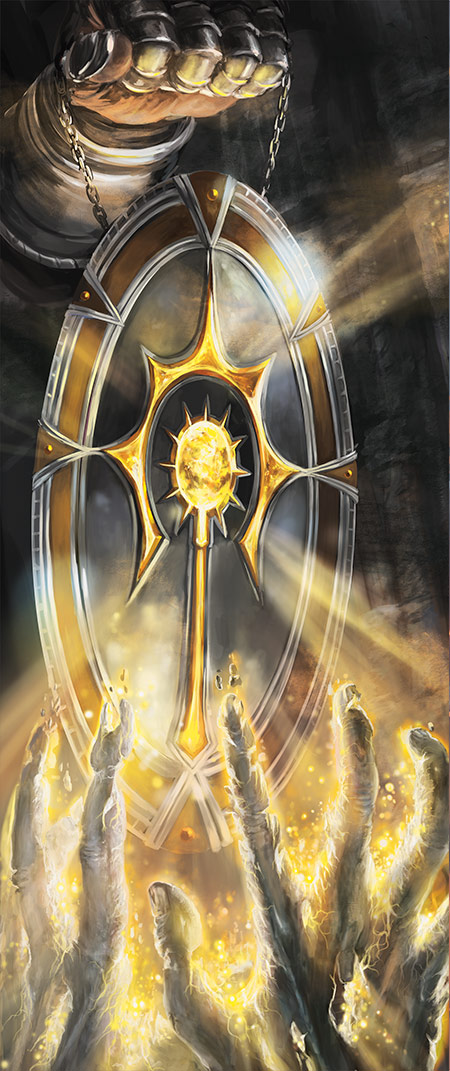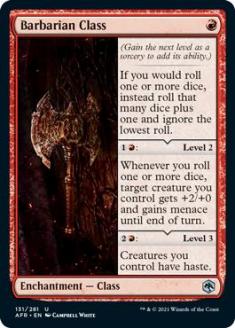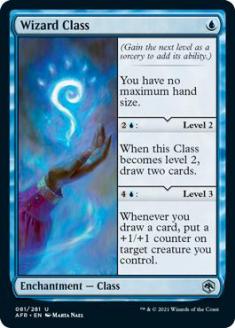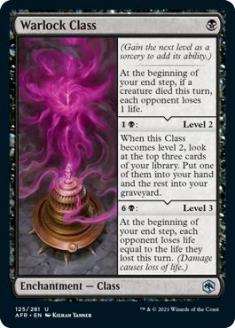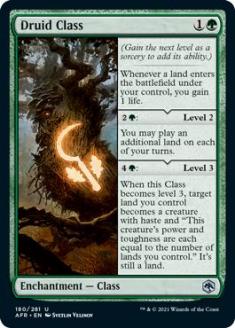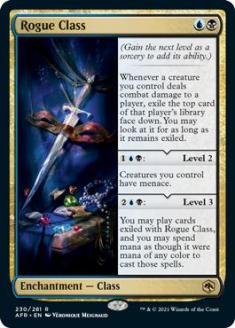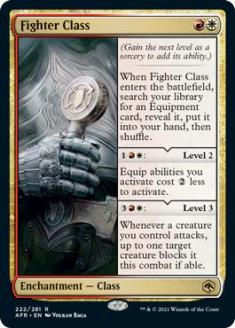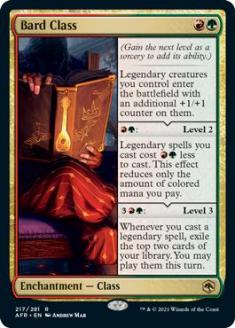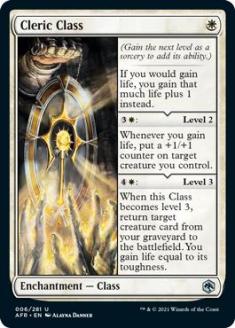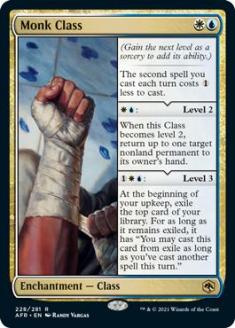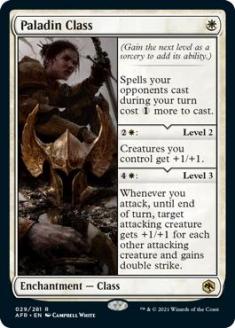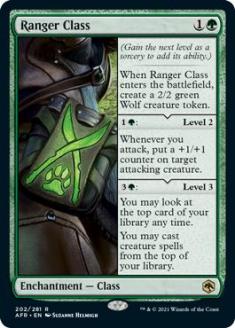Thus far, Dungeons and Dragons: Adventures in the Forgotten Realms has landed a little flat for me. Ok, a lot flat. I’m not a D&D player, but I am actually a huge fan of the source material. I read virtually every book that D&D puts out, and I’m a sucker for its classic fantasy vibes. So what’s going wrong here?
I think there are two main problems. First, even if the individual cards are pointing to the right notes, Adventures in the Forgotten Realms is coming off feeling a little bit too much like Magic warped to present D&D rather than D&D appearing in the world of Magic. It’s a subtle distinction, but one that has a lot to do with whether the set will ultimately be remembered as a love letter, or a pandering cash grab.
The second, and larger problem for me though, is that most of the cards we’ve seen this preview season are just not good. Like, really not good. Power level in Magic is always contextual, but until Throne of Eldraine is gone from Standard, I’ve got to assess the format as presented. In that world, there’s simply not a lot of playable stuff here. Even after Throne of Eldraine’s rotation, a bunch of these cards will pale in comparison to their Kaldheim and Strixhaven counterparts.
A year and two months ago, I wrote an article entitled “I Just Want to Love Constructed Magic Again.” In it, I said the following:
Efforts to up the power level of Standard should have been gradual, and the impact carefully measured. Now we have reached a place where Modern players bemoan the turnover of their favorite decks, and Legacy players have had to shelve their nostalgic favorites that have kept them anchored to the format. All for a Standard that has felt woefully unpopular among the most invested players. And while I understand that focus on the most invested has waned, and perhaps rightfully so, who else is equipped to evaluate the quality of Standard in a historical context?
You can claim the immediate benefit of a power boost, but unless you tread carefully and perfectly thread the needle of power for the foreseeable future of the game, you are setting yourself up for the disappointment (and the associated financial letdown) of a huge course correction in the future. And now, it seems evident to me that course correction is necessary.
I hate running out the “I told you sos” but…
Adventures in the Forgotten Realms is our course correction. Perhaps the general health of the Magic product and a tie-in with an iconic brand will be enough to counteract the financial consequences I predicted, but there’s no denying that we should expect less of an impact from this set in Standard.
Probably.
Despite a clear effort to reduce power of more traditional card types, there’s always the possibility of something getting away from the testing team and proving to be far more powerful than they ever expected. The greatest chance of this happening in Magic always comes when there’s an introduction of a new card type.
Enter Classes. While Classes are just enchantments, they’re playing somewhat differently than the card type usually does. They’re a bizarre mix of mana sink, immediate impact, and persistent value generator. At first glance, no Class seems particularly overpowered to me. But, with new card types, I always like to let the deckbuilding speak for itself. Here are my power rankings as well as some decklists for the twelve Classes appearing in Adventures in the Forgotten Realms.
12. Barbarian Class
As the most insular of the Classes, Barbarian Class was always destined to occupy the bottom of our list. Barbarian Class is virtually requiring you to play a bunch of cards from the weakest set in Standard, and our set of die rolling cards isn’t even complete yet. An enchantment that gives all of your creatures haste is somewhat interesting, but not at six mana. Pass.
11. Wizard Class
Wizard Class falls victim to a bunch of other cards that can fill its role much more competently. The idea of blinking this with Yorion isn’t wholly offensive, but I can’t imagine that you’d ever choose Wizard Class when Omen of the Sea is readily available. Maybe Wizard Class could work as a shoddy anthem effect in the decks that leverage their creatures to draw cards? I’ll offer this for completeness sake, but it’s hard to imagine this outclasses other Adventures decks looking to do similar things.
Creatures (32)
- 4 Lovestruck Beast
- 4 Giant Killer
- 4 Edgewall Innkeeper
- 4 Brazen Borrower
- 3 Toski, Bearer of Secrets
- 1 Clarion Spirit
- 4 Jaspera Sentinel
- 2 Reidane, God of the Worthy
- 4 Elite Spellbinder
- 2 Grazilaxx, Illithid Scholar
Lands (17)
Spells (11)
- 3 Forest
- 2 Plains
- 2 Island
- 4 Wizard Class

The ideas here all kind of work. We draw a lot of cards. The sizing of our creatures matters a lot. Maybe we even want to end turns with more than seven cards in hand. Grazilaxx, Illithid Scholar is nice with all of our Adventure creatures, and is even ready to play the role of a backup Toski, Bearer of Secrets. But yeah, Bonecrusher Giant and Showdown of the Skalds are still out there, doing a lot of these tricks just as efficiently with better overall card quality.
10. Warlock Class
I love me exactly the kind of smallball nonsense that Warlock Class is getting up to, but even I have a limit to how smallball I’m willing to go. Most of my efforts to push this were unsurprisingly geared towards Plumb the Forbidden decks, which picked up another decent tool in the form of Shambling Ghast. I convinced myself that Warlock Class could only be playable if I was also getting value from my graveyard, so I ultimately ended up here.
Creatures (29)
- 4 Dread Warlock
- 3 Gray Merchant of Asphodel
- 3 Murderous Rider
- 1 Ayara, First of Locthwain
- 4 Fiend Artisan
- 4 Skyclave Shade
- 4 Eyetwitch
- 1 Gelatinous Cube
- 1 Ebondeath, Dracolich
- 4 Shambling Ghast
Lands (26)
Spells (5)
Sideboard

Possibly the biggest get for Mono-Black decks is that they now get to play 26 lands with the printing of Hive of the Eye Tyrant. For a deck that can’t miss land drops but also needs to extract value from all of its cards, this is a huge blessing. Still, this is another Gray Merchant of Asphodel deck during preview season. I’ve proposed about 300 of these at this point, and every one has been exceedingly medium. Expect nothing different here.
9. Druid Class
Druid Class creeped up this list a bit based mostly on potential. Azuza, Lost but Seeking currently exists and does the best part of Druid Class for far less of an investment. However, in a theoretical format similar to the one dominated by Nissa, Who Shakes the World — where land counts are extremely high and games are about ever larger snowballs —you could see a sturdier version of this effect make some waves. Granted, the format’s power level would have to be a bit lower than the one shaped by Nissa and friends, but that space could plausibly exist. For the time being, I don’t have a home for this one, but its potential output ranges higher than the rest of our early entrants.
8. Rogue Class
My early passes of this list had Rogue Class much higher, but the more I considered the actual play patterns involved, the less I believed. Rogue Class with no advancement does almost nothing. It doesn’t scale well in multiples. The types of decks that are interested in Rogue Class like, well… Rogues, generally won’t benefit much from menace. And while I could see game breaking output from a Rogue Class that has been fueled, it only gets there after a whopping nine mana worth of investment and even then you better hope your Rogue Class remains on the battlefield. Too much has to go right for this card to matter, and the type of creatures Dimir decks are playing would have to look very different for this to be great.
7. Fighter Class
The name of the game with Fighter Class is consistency. Equipment are slowly floating back to the powerhouses they used to be. When Nahiri, Heir of the Ancients was first previewed, a lot of us thought it had Standard potential. Maybe the tutoring of Fighter Class is exactly what the card needs to make it big.
Creatures (24)
- 4 Seasoned Hallowblade
- 4 Kor Blademaster
- 1 Akiri, Fearless Voyager
- 4 Kargan Warleader
- 4 Fireblade Charger
- 1 Halvar, God of Battle
- 1 Koll, the Forgemaster
- 1 Resplendent Marshal
- 4 Usher of the Fallen
Planeswalkers (3)
Lands (10)
Spells (23)

If Nahiri, Heir of the Ancients can’t carry the load, eventually a powerful piece of Equipment is going to come along and change Standard. I’m medium on this particular deck since it reads like Mono-White Aggro❄ minus the explosiveness, but long on Fighter Class’s chances of eventually making an impact.
6. Bard Class
Bard Class lacks the immediate battlefield impact of some of its rare peers, but gains a lot of points for a very mana efficient Level 2 and a potentially game breaking Level 3. There are some legit legendary options out there right now, and I’m kind of excited to give this deck a try.
Creatures (27)
- 1 Korvold, Fae-Cursed King
- 2 Questing Beast
- 1 Klothys, God of Destiny
- 1 Chevill, Bane of Monsters
- 1 Tangled Florahedron
- 4 Magda, Brazen Outlaw
- 3 Valki, God of Lies
- 2 Kolvori, God of Kinship
- 4 Esika, God of the Tree
- 4 Jaspera Sentinel
- 4 Orcus, Prince of Undeath
Lands (19)
Spells (14)

The superstar here looks to be Orcus, Prince of Undeath. In a set with very few standalone game changers, Orcus, Prince of Undeath impresses me. Orcus’s best selling point is how strong it plays as a four-mana creature. 5/3 trampling, flying is going to open up some fast wins for a midrange strategy. However, Orcus can just go off in the late-game should you get to that point. Given all of the mana generation we have access to with Esika, God of the Tree; Jaspera Sentinel; Magda, Brazen Outlaw, and the Bard Class itself, I expect some game breaking output to come from our Orcus. Even if Bard Class isn’t the key to unlock Orcus, expect it to be a Standard difference maker. It might be the best card previewed thus far.
5. Cleric Class
Mono-White Lifegain decks have a lot of solid tools already, and there have probably been moments where the deck was a legit option that just got slept on. Cleric Class is bringing redundancy for the core “gain life, get big” mechanic, and a way to buyback key scaling creatures as the game goes long. There’s a pretty obvious build slotting this into the already existing packages but I wonder, is Cleric Class the thing that finally allows us to play this gameplan with a companion Lurrus of the Dream-Den?
Creatures (30)
- 4 Charming Prince
- 4 Daxos, Blessed by the Sun
- 4 Alseid of Life's Bounty
- 2 Selfless Savior
- 4 Speaker of the Heavens
- 4 Skyclave Cleric
- 4 Luminarch Aspirant
- 4 Dawnbringer Cleric
Lands (4)
Spells (26)
Sideboard

I expect it’ll be hard to get away from tools like Elite Spellbinder and Skyclave Apparition, but where a more linear approach has an opportunity to shine, this deck has some potential.
4. Monk Class
Monk Class is super interesting to me, because where it feels like every other Class is looking to pair up with creatures, Monk Class is happy to just be a fine card on its own. I really like the way Monk Class looks in a tap-out control deck, but it’s unlikely an approach like this can unseat things like Sultai Ramp (Yorion) for the time being. Post-rotation, I’ll be looking to play some spells with mana flexibility like Multiple Choice and Niko Aris alongside Iymrith, Desert Doom — a Dragon that feels like the prototypical tap-out control finisher. Monk Class should fuel this gameplan nicely by speeding up double spell turns, buying time with its bounce capability, and eventually generating persistent card advantage at Level 3.
It’s too early to propose this kind of list now, but this is definitely getting added to my to-do pile.
3. Sorcerer Class
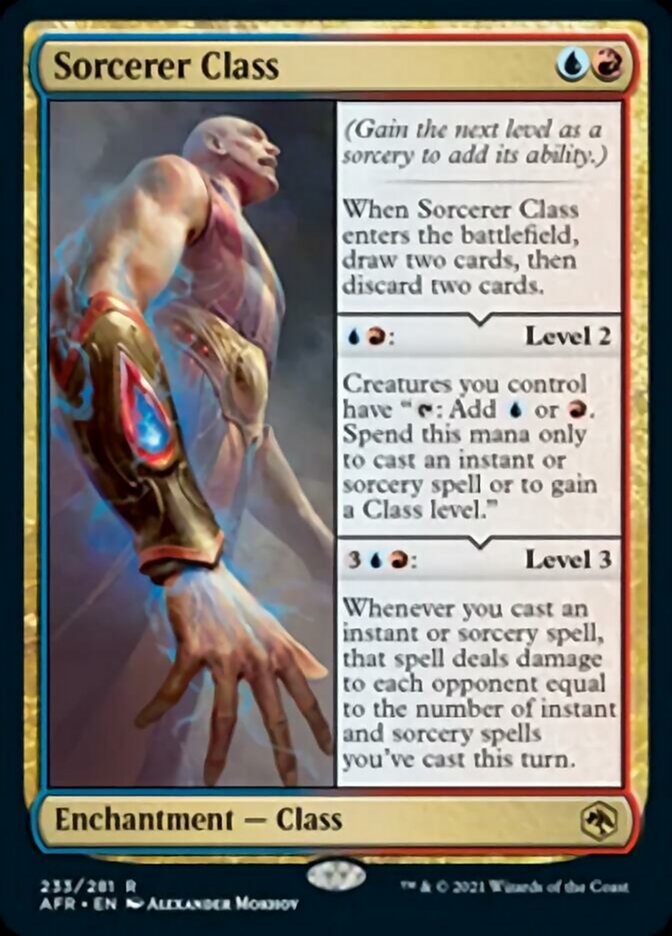
Sorcerer Class shines with some worthwhile and immediate output. I’ve happily paid UR to draw two, discard two in the past, and Sorcerer Class is giving me plenty of options beyond that point. I think I would have this card higher if not for the fact that the existing Izzet decks are already quite good, and rebuilding to maximize Sorcerer Class is likely a trap. However, powering out our Alrund’s Epiphany matters a lot in racing situations. The deck is at least owed some due diligence.
Creatures (15)
Lands (26)
Spells (15)

This deck, like many in Strixhaven Standard, owes a lot to its Adventure creatures. It’s able to really use all parts of the Sorcerer Class buffalo due to the spell and creature density the Adventures provide. Magda, Brazen Outlaw in conjunction with Sorcerer Class is going to get up to some mana generating shenanigans, and once that happens, I see no reason why Sorcerer Class can’t fuel storm-esque kills on otherwise stalled battlefields. This deck looks legit, but how much of that is just based on the already established core remains to be seen.
2. Paladin Class
Paladin Class isn’t doing anything flashy, but it’s so good at what it does. When the tax matters, it will provide value way beyond what a one-mana card is expected to bring to the table. Meanwhile, it’s also extremely adept at just getting your opponents dead. No need to reinvent the wheel here. Pop this card in Mono-White Aggro❄, mess with your opponent’s timings, and watch how easy it is to turn otherwise ineffectual creatures into alpha striking menaces. This card is going to make a lot of Elite Spellbinders lethal, and it’s possible Paladin Class completely supplants Maul of the Skyclave as the best form of reach for Mono-White Aggro❄.
1. Ranger Class
Ranger Class has to top this list because it is the least demanding in deckbuilding. As a self-contained 2/2 creature with huge late-game upside, it’s worth serious consideration in multiple green decks. As long as you’re creature dense, it doesn’t really matter what your gameplan looks like. Ranger Class is potential card advantage that give up zero of its beatdown potential, and it’s ready to instantly catapult Mono-Green Aggro back into Tier 1.
Creatures (27)
- 2 Scavenging Ooze
- 4 Lovestruck Beast
- 2 Questing Beast
- 4 Stonecoil Serpent
- 3 Gemrazer
- 4 Swarm Shambler
- 4 Kazandu Mammoth
- 4 Werewolf Pack Leader
Lands (23)
Spells (10)

Ranger Class plays beautifully with Swarm Shambler and Gemrazer and has the potential to push out an even faster The Great Henge. This deck also picked up Werewolf Pack Leader as a secondary (tertiary?) source of card advantage and yet another mana sink. Seriously, Mono-Green Aggro❄ looks primed for a big time run at the start of next Standard season. It’s lost none of its beatdown capabilities and picked up two incredible late-game tools.
Doing the work for this article started to instill some rays of hope in me. Granted, the best of the decks offered here are mostly rehashes of already existing archetypes. But there have been moments during preview season when I seriously doubted if any of these cards were going to see play. Now I’m mostly convinced that there are a few solid roleplayers available and maybe even one or two gamechangers. That’s a completely acceptable set at most times in Magic’s history. It’s just producing a little whiplash coming on the heels of the last few years.
I guess we had to start readjusting at some point though.

